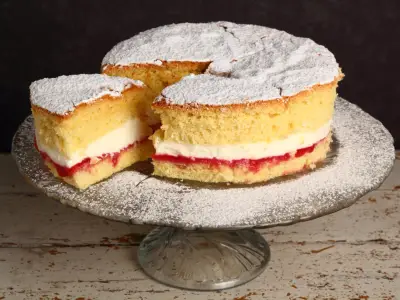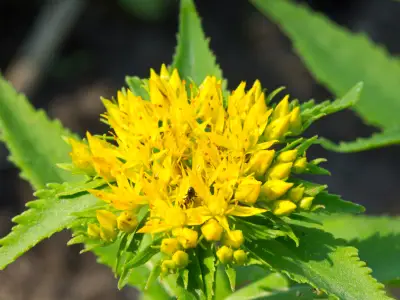Even though it fuels and nourishes our bodies, many of us are guilty of taking for granted the incredible processes that aid digestion — so much so, that minor complaints of the gut are commonplace and yet we learn to just live with them. However, there are delicious and simple ways in which we can promote healthy digestion in our bodies through the use of herbal remedies and recipes. So, let’s learn how to make ginger tea to aid a happy and healthy gut.
Bitters are a key component in herbal digestive aids as they boost the secretion of saliva in the mouth — the first stage of digestion. Bitter tastes also stimulate peristalsis, are found to encourage a diminished appetite, and stabilise blood sugar levels.

Of course, ginger is one of the most commonplace and delicious bitter tastes in the natural world.
The Qualities of Ginger
Ginger’s scientific name is Zingiber Officinale. There are many species in the ginger family, such as the Java ginger pictured below, and they all have differing qualities.
For example, this Java ginger — or Temulawak — is a liver protection herb that is said to be able to heal inflammation and boost longevity and its rhizome (or root) is often used in energising drinks.

We’ll focus on the most commonly found ginger. You’ll likely be familiar with its warm, spicy and earthy flavours popularised by large corporate coffee chains.
You might not, however, be aware of its extensive therapeutic properties, some of which are listed below:
- Analgesic
- Anti-inflammatory
- Antimicrobial
- Antispasmodic
- Circulatory stimulant
- Emmenagogue
- Immunostimulant
- Rubefacient
These benefits are why ginger has been used in ayurvedic balancing tea traditions since between 500 to 1000 BCE.

For this guide on how to make ginger tea for gut detoxing, we are particularly interested in ginger’s carminative, diaphoretic, antiemetic, and digestive therapeutic qualities. They make ginger an excellent herb to use in teas that can ease bloating, wind, vomiting, and nausea.
It’s important to note that ginger has a few contraindications: Do not use ginger alongside anticoagulants or in cases of gallstones or peptic ulceration.
You can drink ginger tea as a simple — enjoying its flavour profile alone — or as a blend with other herbs to alter the qualities of the tea. Due to ginger’s hardy roots, you can infuse or decoct it alongside other herbs, depending on the herbs you plan on blending.
We’ll guide you through both infusion and decoction.

How to Make Ginger Tea by Infusion
Infusion is the ideal method for making ginger tea if you’re choosing to blend it with other, more delicate herbs from which the flavour is extracted from leaves, flower heads, or petals. If your blend has more of these delicate herbs, opt for an infusion and add a little more ginger to counter the fact that infusion may not liberate some of the tougher parts of the ginger’s active constituents.
In this scenario, you must chop your ginger as finely as possible to extract the most benefit from a large surface area of the ginger. Some herbalists choose to grind or crush ginger, too.
For this method, you will prepare the herbal blend and steep it in boiling water. Use a teapot to insulate the liquid and regulate temperature at the boiling point more easily. A time of 10 minutes will do for an enjoyable beverage or 15 for a therapeutic tea. Strain before drinking.

Here are some infusion blends you can try on your journey to discover how to make ginger tea.
Digestive Ease Blend
¼ part ginger
⅛ part cinnamon
½ part lemon verbena
1 part lemon balm
1 part German chamomile
1 part spearmint
After Dinner Fennel Tea
¼ part ginger
⅛ part cardamom
½ part liquorice
1 part meadowsweet
1 part lemon verbena
2 parts fennel seed

How to Make Ginger Tea by Decoction
A decoction is an ideal method for making ginger tea if you’re choosing to blend it with other, hardy herbs, from which the flavour is extracted from nuts, dried berries, or bark. If your blend has more of these tough herbs, opt for a decoction and make sure to add a little more of the delicate herbs in your blend to minimise the risk of damage or evaporation.
For this, you may chop your ginger as you like but, to slice finely will help to extract the most benefit – producing a large surface area of the ginger. Some herbalists choose to grind or crush ginger, too.
For this method, you will prepare the herbal blend and place it in simmering water. Use a teapot or covered vessel to insulate the liquid and regulate temperature at about 90°C. 20 minutes will do for an enjoyable beverage or 40 for a therapeutic tea. Add a little water at the end of simmering if the taste is too strong. Strain before drinking.

Here are some decoction blends you can try on your journey to discover how to make ginger tea that suits your needs and tastes.
Digestive Warmth Blend
¼ part ginger
⅛ part aniseed
¼ part fennel
½ part marjoram
1 part oat straw
2 parts angelica root
Bitter Blend
¼ part ginger
¼ part fennel
½ roasted chicory root
½ part dandelion root
1 part German chamomile
Bacterial Buddy Tea
½ part ginger
½ part cinnamon
¼ part pau d’arco
1 part fennel
1 part burdock root
1 part chicory root
2 parts meadowsweet

Here are some final tips on how to make ginger tea the most effective herbal remedy for digestive problems. It is generally advised that you drink your tea half an hour before eating, as the remedy is best administered in advance.
There are also some safety considerations to account for; just because all herbs are natural doesn’t mean that every herb is the right herb for you. A number of herbs, for example, have the potential to interact with certain medications such as liquorice, St. John’s Wort, herbs high in tannins, herbs with laxative qualities, or emmenagogues during pregnancy. For this reason, as a rule of thumb, all herbal treatments should be stopped a fortnight in advance of any scheduled surgery.
With digestive detoxes, there are of course contraindications; bitter herbs that stimulate digestive secretions, for example, should not be administered in the case of a blocked gall duct.

It’s also a great idea to source your ginger locally and from reputable harvesters. A good harvester should be able to tell you about the farm on which your herbs were grown, when they were grown and how they’ve been dried; all factors that will affect the taste and properties of the ginger. And finally, make sure to keep your herbs fresh for longer by storing them in a dark, dry container.
With time, you will learn to develop your own eye, nose and taste for ginger on your journey to discover how to make ginger tea to suit your needs and develop your own methods on the way to happy digestive health.
At the time of publishing, entering the code LEARNING in the checkout will reduce the price of our
Herbal Tea Blending Diploma Course to £29.





